Nematodes represent a significant challenge for Brazilian agriculture, causing billions in losses annually, especially in soybean crops.
The impact of parasitism by these species on soybean productivity can vary between 10% and 90%, depending on the species and the level of infestation. In 2015, losses in soybean crops were estimated at over R$16 billion.
The significant increase in nematodes is primarily attributed to monoculture of host plants, intensive production systems with low crop diversity (which act as multipliers), and inadequate diagnosis of the problem by producers, who may confuse the symptoms with other issues such as soil compaction or nutritional deficiency.
Among the main phytonematodes in the Brazilian Cerrado, we can highlight:
Soybean Cyst Nematode (Heterodera glycines)
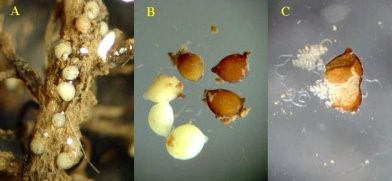
Figure 1. Heterodera glycines, the soybean cyst nematode (A) females in roots; (B) mature females and cysts; and (C) ruptured cyst (with eggs and J2) obtained from soil cultivated with soybeans. Source: H. D. Campos.
It was detected in Brazil during the 1991/92 harvest and is considered the species with the greatest potential for damage to soybeans. Infested areas present underdeveloped plants and marked yellowing of the leaves, usually in the scion areas. It is characterized by the formation of brown cysts (the body of the dead adult female), which are highly resistant to adverse conditions and can contain 200 to 400 eggs, remaining viable in the soil for approximately eight years.
Root-Knot Nematode (Meloidogyne javanica and M. incognita)
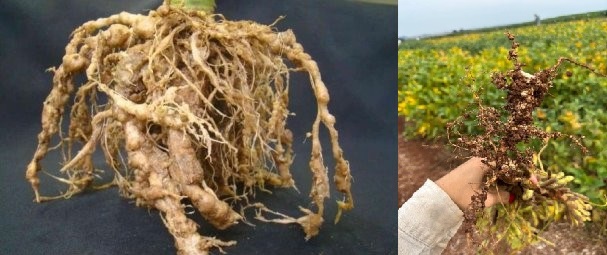
Figures 2 and 3. Symptoms of Meloidogyne spp. Source: personal collection (2024) (fig 3; https://agropos.com.br/nematoides-da-soja/. (fig 2).
They cause stunted growth and yellowing of the aerial parts of plants. In some cases, the leaves may present chlorotic spots and necrosis between the veins, known as "carijó" leaves. In the root system, they form galls, which are clearly visible abnormal thickenings (as in the figures), compromising water and nutrient absorption and potentially leading to tissue destruction.
Root lesion nematode (Pratylenchus brachyurus)
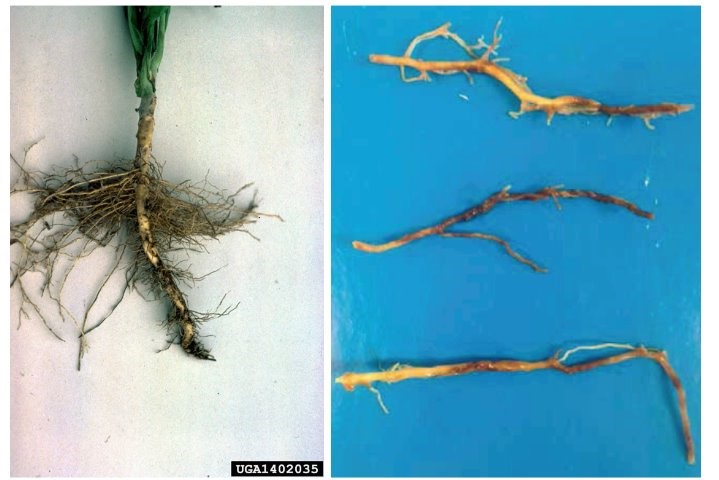
Figure 4. Roots with symptoms of root rot caused by Pratylenchus brachyurus: Reduced number of rootlets (left – Photo: R.J. Reynolds Tobacco Company, R.J. Reynolds Tobacco Company, Bugwood.org) and Pepper roots cv. Biquinho with necrotic lesions (right – Photo: Oliveira et al., 2018).
Currently, it is one of the biggest problems for soybean crops, being the most common species within the Pratylenchus genus in Brazil and extremely polyphagous, parasitizing several economically important crops. The main symptom is severe plant underdevelopment, accompanied or not by leaf yellowing. In the roots, it causes an abrupt reduction in the volume of the The root system appears dark and necrotic due to colonization by opportunistic fungi and bacteria.
Sampling and Diagnosis
Symptoms in crops occur in patches or patches, with yellowing of the plants, irregular growth, and wilting during warmer, drier periods. Symptoms in roots range from thickening (galls), decreased volume and growth, and partial destruction with dark lesions.
It is crucial to understand that visual symptoms are only indicative. For effective management, root and soil samples must be sent to a laboratory, as instructed in Figure 6, for nematology, for correct species identification and population quantification.
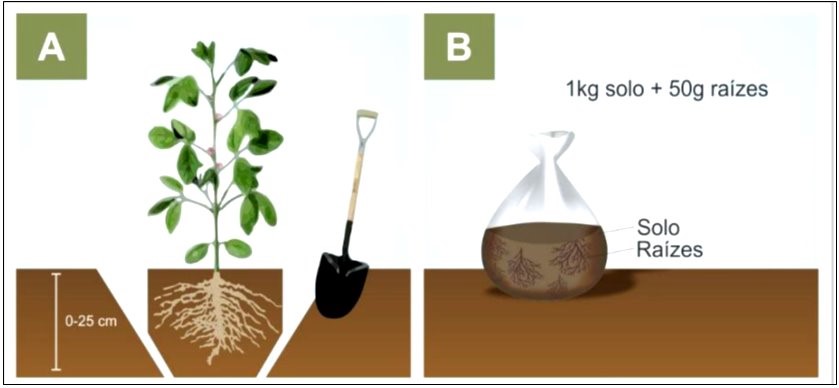
Figure 5. Simple scheme for collecting soil and roots for analysis. Source: Cultivar Magazine (2021).
Samples can be collected for analysis at flowering or between 50 and 70 days after planting. To ensure greater reliability, it is recommended to collect soil and roots from different points of the affected area (approximately 5 to 10 points per hectare), ultimately gathering approximately 1 to 2 kg of soil and 50 g of roots (Figure 5). The sample should then be sent quickly to a laboratory, preferably packed in a Styrofoam box to avoid sudden temperature fluctuations.
Nematode Control
Integrated nematode management should be viewed as a set of strategies aimed at reducing the population of these organisms in the soil while simultaneously preserving the crop's productive potential. The first principle is prevention, which includes simple measures such as properly cleaning agricultural machinery and implements, preventing the spread of nematodes between fields and properties. Furthermore, weed control during the off-season is essential, as many species act as hosts, maintaining populations in the field.
In addition to these measures, cultural practices play a fundamental role in managing this parasite. Crop rotation or succession with non-host species interrupts the nematode cycle, reducing their density in the soil. The use of antagonistic plants can also be effective, as some release toxic substances or hinder parasitism, contributing to population declines, as shown in the study below.
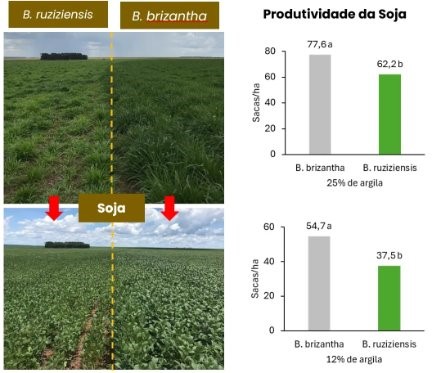
Figure 6. Soybean productivity two years after pasture. Source: Adapted from Silva (2022).
From a genetic perspective, the use of resistant cultivars has proven to be a practical and efficient alternative. Some soybean varieties are resistant to important species, such as root-knot nematodes and cyst nematodes. This strategy reduces direct damage to the crop and helps limit the multiplication of these species in the soil.
Finally, the use of chemical or biological nematicides is undoubtedly one of the main strategies employed by producers. Chemicals act by protecting the root system, especially during the early stages of plant development. Currently, nematode control is primarily achieved through seed treatment and in-furrow application, both aimed at protecting seedlings.




